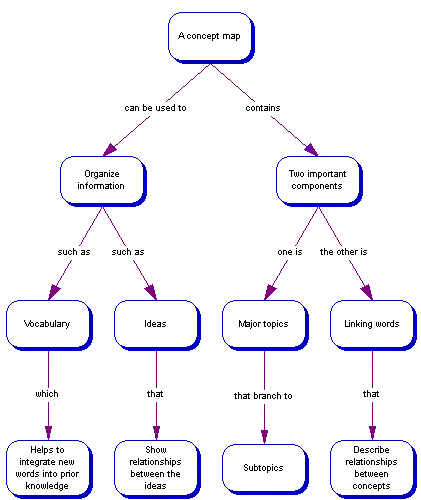Constructing a Concept Map of the Characteristics of Life
Objective: Students will work in groups to construct a concept map of the characteristics of life that demonstrates their knowledge of the attributes and criteria used by biologists to measure life
1.Brainstorming Phase: Identify facts, terms, and ideas that you think are in anyway associated with the topic. Make a list of these items and print them neatly on small Post-It notes, one per note, in very brief form, i. e. a single word or short phrase. This is a brain-storming process, so write down everything that anybody in your group thinks is important and avoid discussing how important the item is. Don't worry about redundancy, relative importance, or relationships at this point. Your objective here is to generate the largest possible list you can. Before your group completes this step, you may have more than 50 items.
2. Organizing Phase: Spread out your concepts (Post-It notes) on a flat surface so that all can be read easily and, together, create groups and sub-groups of related items. Place your CENTRAL THEME in the middle of the terms. For this project, the theme of the map is "LIFE CHARACTERISTICS". Try to group items to emphasize relationships. Feel free to rearrange items and introduce new items that you omitted initially. Note that some concepts will fall into multiple groupings.
3. Linking Phase: Use lines with arrows to connect and show the relationship between connected items. Write a word or short phrase by each arrow to specify the relationship. Many arrows can originate or terminate on particularly important concepts. Arrows should only go one way, and each arrow should have a linking phrase attached to it.
Example of a Concept Map - On Concept Maps

| Rarely (1) | Sometimes (2) | Frequently (3) | Extensively (4) | |
| Overall | The concept map does not seem to have a focus. | The purpose of the concept map is not clear. Few characteristics of life are represented. | The concept map has a focus, though it is somewhat disjointed or difficult to decipher. Most characteristics of life are represented. | The concept map clearly has a focus and a purpose. A casual viewer would understand what the map is trying to convey. All characteristics of life are represented as seen in your text or notes. |
| Terms | Very few relevant terms present | Not enough terms are used to show clear relationships and purpose or many terms are irrelevant | Extensive use of terms, a few obvious points missing, or irrelevant terms present | An extensive use of terms and vocabulary used in the map. Terms are relevant. |
| Links | Many links not clear and unlabeled. Failure to show relationships. | Some links not clear or unlabeled. Relationships between ideas poorly established. | Links show the relationships between concepts. A few terms have more than one link present. | Links clearly show the relationships between concepts. Most of the concepts have more than one link present |
| Technical | Map somewhat difficult to follow. Organization poor or impossible to follow | Map easy to read and to follow. Organization fair. | Map easy to read and to follow. Organization good. No grammar or spelling errors. |
Other Activities on Building Concept Maps
Introduction to Concept Mapping
